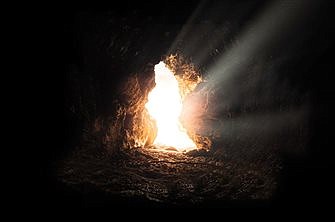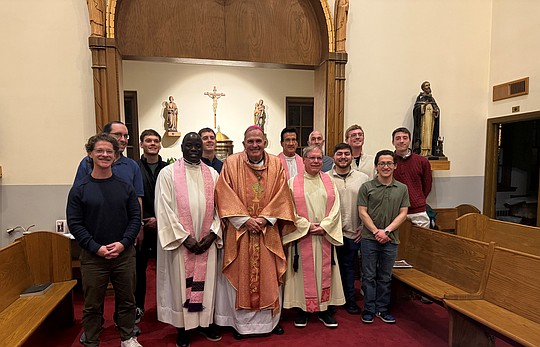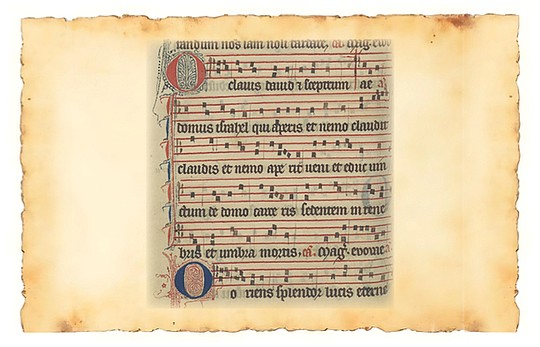Father Koch: Faith seeks to understand
March 30, 2021 at 9:14 p.m.

At first all anyone knows is that the tomb is empty.
Mary Magdalene went to the tomb of Jesus in the pre-dawn hours of that last usual Sunday morning of all time and saw that the stone was moved and that Jesus was gone.
Jesus had spoken, and spoken often, about the coming resurrection from the dead. Yet, somehow she remained in the darkness and could not yet apprehend what was happening around her. She will not be alone in her confusion. Running strong through the serpentine streets of Jerusalem Mary came to the room where Peter and the others were holed up and pondering their own futures.
We might expect that as it was so early that some of them were groggy from a rough night’s sleep coupled with the trepidation that must have overwhelming as they faced another day of uncertainty. They never knew if or when the Temple officials might come after them, too. Peter and the so-called “beloved disciple” headed off immediately, retracing the steps of Mary Magdalene as they ran towards the tomb. Younger and perhaps more filled with hope and expectation, the beloved arrived first at the tomb, but remained outside waiting for Peter. Peter, impetuous as ever, went straight in to the tomb, followed then by the other disciple. Mary followed along and arrived at the tomb sometime later. We do not know at what time the sun broke through the horizon that morning, but the beloved disciple, as he followed Peter into the tomb, “saw and believed.” Even in the stark darkness of that empty tomb he knew what had happened, he was now waiting for Peter to confirm what he saw. He was the first to move from the darkness to the light. He remains, silent, though, as Peter rummaged through the tomb, saying nothing. We do not know what Peter must have thought of all of this.
Faith, as seen in the beloved disciple, and the concurrent lack of faith, as seen in Mary Magdalene, serve as the undercurrent running through this most important of all moments in time. Mary bewildered and, perhaps overcome with grief, is unable to see through the darkness into a glimmer of the light. Her own encounter with the Resurrected One, though poignant, is not part of the Gospel we hear on Easter Sunday. It takes a spoken word from Jesus, and his physical presence, for her to understand.
Peter and the beloved disciple each have their own reasons for heading with haste to the tomb. The other 10 disciples have their own reasons for not going. It likely would have brought much suspicion if eleven men were racing through the streets of Jerusalem so early in the morning. Certainly Peter, as the doyen of the disciples had to go, and the beloved, as the youngest could certainly get there in haste and assess the situation. We can only muse on what the others are making of what is going on around them. Did Mary stay behind for a while talking, or perhaps, rambling on about what she saw and felt along the way? What compelled her to leave them and head back to tomb again, on her own, alone?
The beloved, certainly less rash and likely more introspective, peers through the darkness and sees the glimmer of light leading him to faith. The author of the Gospel reflects: “… and he saw and believed. For they did not yet understand the Scripture that he had to rise from the dead.”
Herein, too, is born the roots of a new language – that of Christian theology – as it is through his response in belief that the beloved seeks to understand. Indeed, some 13 centuries later St. Augustine of Canterbury defined theology as precisely that: “fides quaerens intellectum” (“faith seeking understanding”).
The faith that wells up within us seeks the language and categories to express itself. Of course, whenever we articulate anything of profound intimacy or importance we genuinely find that human language is itself inadequate. Whatever the beloved disciple experienced as he entered that empty tomb, as he struggled first to understand and then to express that understanding, the words failed the awesomeness of that experience. Yet, the only way that we can evangelize another, much less the whole world, is to express faith-in-language. Sometimes that is the language of philosophy, sometimes the language of experience, sometimes the language of relationship, but it is always the language of love – God’s love for us, and our love for one another.
Nowhere is this love more deeply presented than in the events of this past week – the Passion, Death and Resurrection of Jesus Christ. This encounter with the resurrected one is a language unto itself, leading us all into a deeper relationship with the Lord.
Father Garry Koch is pastor of St. Benedict Parish, Holmdel.
Related Stories
Monday, December 15, 2025
E-Editions
Events
At first all anyone knows is that the tomb is empty.
Mary Magdalene went to the tomb of Jesus in the pre-dawn hours of that last usual Sunday morning of all time and saw that the stone was moved and that Jesus was gone.
Jesus had spoken, and spoken often, about the coming resurrection from the dead. Yet, somehow she remained in the darkness and could not yet apprehend what was happening around her. She will not be alone in her confusion. Running strong through the serpentine streets of Jerusalem Mary came to the room where Peter and the others were holed up and pondering their own futures.
We might expect that as it was so early that some of them were groggy from a rough night’s sleep coupled with the trepidation that must have overwhelming as they faced another day of uncertainty. They never knew if or when the Temple officials might come after them, too. Peter and the so-called “beloved disciple” headed off immediately, retracing the steps of Mary Magdalene as they ran towards the tomb. Younger and perhaps more filled with hope and expectation, the beloved arrived first at the tomb, but remained outside waiting for Peter. Peter, impetuous as ever, went straight in to the tomb, followed then by the other disciple. Mary followed along and arrived at the tomb sometime later. We do not know at what time the sun broke through the horizon that morning, but the beloved disciple, as he followed Peter into the tomb, “saw and believed.” Even in the stark darkness of that empty tomb he knew what had happened, he was now waiting for Peter to confirm what he saw. He was the first to move from the darkness to the light. He remains, silent, though, as Peter rummaged through the tomb, saying nothing. We do not know what Peter must have thought of all of this.
Faith, as seen in the beloved disciple, and the concurrent lack of faith, as seen in Mary Magdalene, serve as the undercurrent running through this most important of all moments in time. Mary bewildered and, perhaps overcome with grief, is unable to see through the darkness into a glimmer of the light. Her own encounter with the Resurrected One, though poignant, is not part of the Gospel we hear on Easter Sunday. It takes a spoken word from Jesus, and his physical presence, for her to understand.
Peter and the beloved disciple each have their own reasons for heading with haste to the tomb. The other 10 disciples have their own reasons for not going. It likely would have brought much suspicion if eleven men were racing through the streets of Jerusalem so early in the morning. Certainly Peter, as the doyen of the disciples had to go, and the beloved, as the youngest could certainly get there in haste and assess the situation. We can only muse on what the others are making of what is going on around them. Did Mary stay behind for a while talking, or perhaps, rambling on about what she saw and felt along the way? What compelled her to leave them and head back to tomb again, on her own, alone?
The beloved, certainly less rash and likely more introspective, peers through the darkness and sees the glimmer of light leading him to faith. The author of the Gospel reflects: “… and he saw and believed. For they did not yet understand the Scripture that he had to rise from the dead.”
Herein, too, is born the roots of a new language – that of Christian theology – as it is through his response in belief that the beloved seeks to understand. Indeed, some 13 centuries later St. Augustine of Canterbury defined theology as precisely that: “fides quaerens intellectum” (“faith seeking understanding”).
The faith that wells up within us seeks the language and categories to express itself. Of course, whenever we articulate anything of profound intimacy or importance we genuinely find that human language is itself inadequate. Whatever the beloved disciple experienced as he entered that empty tomb, as he struggled first to understand and then to express that understanding, the words failed the awesomeness of that experience. Yet, the only way that we can evangelize another, much less the whole world, is to express faith-in-language. Sometimes that is the language of philosophy, sometimes the language of experience, sometimes the language of relationship, but it is always the language of love – God’s love for us, and our love for one another.
Nowhere is this love more deeply presented than in the events of this past week – the Passion, Death and Resurrection of Jesus Christ. This encounter with the resurrected one is a language unto itself, leading us all into a deeper relationship with the Lord.
Father Garry Koch is pastor of St. Benedict Parish, Holmdel.










